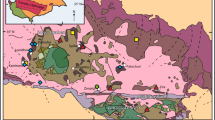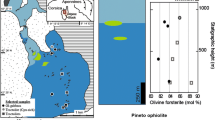Abstract.
Felsic alkalic rocks are a minor component of many ocean island volcanic suites, and include trachyte and phonolite as well as various types of alkaline and peralkaline rhyolite. However, there is considerable debate on the nature of their formation; for example, are they formed by partial melting of anomalous mantle or the final products of fractional crystallization of mafic magmas. The phonolites and foidal phonolites on Rarotonga were formed by low pressure crystal fractionation of two chemically distinct parental magmas. Low silica and high silica mafic magmas produced a basanite–foidal phonolite series and an alkali basalt–phonolite series, respectively. The foidal phonolite composition evolved from the low silica mafic magmas by approximately 60% fractionation of titanaugite + leucite + nepheline + magnetite + apatite. Fractionation continued with the crystallization of aegirine-augite + nepheline + kaersutite + magnetite + apatite. The phonolites formed from the alkali basalts by approximately 40% fractionation of kaersutite + titanaugite + Fe–Ti oxide + plagioclase + apatite and continued to evolve further by fractionation of anorthoclase + nepheline + aegerine-augite + Fe–Ti oxides. As the magmas fractionated in both suites, their overall viscosities (solid + liquid) increased until a point was reached whereby viscosity inhibited the eruption of magmas with compositions intermediate between the mafic rocks and the felsic rocks. However, the magmas continued to fractionate under static conditions with the residual fluid becoming foidal phonolitic in the low silica suite or phonolitic in the high silica suite. These phonolitic liquids, as a result of an increase in volatiles and enrichment of alkalis over aluminum, would actually have a lower viscosity than the intermediate liquids. This decrease in viscosity and the switch from a magma chamber being predominantly a liquid with suspended solids to a solid crystalline network with an interstitial liquid enabled phonolitic liquids to migrate, pool, and eventually erupt on the surface.
Similar content being viewed by others
Author information
Authors and Affiliations
Additional information
Electronic Publication
Rights and permissions
About this article
Cite this article
Thompson, .G., Smith, .I. & Malpas, .J. Origin of oceanic phonolites by crystal fractionation and the problem of the Daly gap: an example from Rarotonga. Contrib Mineral Petrol 142, 336–346 (2001). https://doi.org/10.1007/s004100100294
Received:
Accepted:
Issue Date:
DOI: https://doi.org/10.1007/s004100100294




